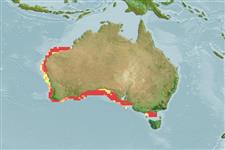Elasmobranchii (Haie und Rochen) (sharks and rays) >
Rhinopristiformes (Shovelnose rays) >
Trygonorrhinidae (Banjo rays, Fiddler rays)
Etymology: Aptychotrema: Greek, a = without + Greek, ptyx, ptychos = fold + Greek, trema = hole (Ref. 45335).
Environment: milieu / climate zone / depth range / distribution range
Ökologie
seewasser demersal; tiefenbereich ? - 125 m (Ref. 114953). Temperate; 19°S - 40°S, 112°E - 147°E (Ref. 114953)
Eastern Indian Ocean: endemic to western and southern Australia.
Size / Gewicht / Alter
Maturity: Lm ? range ? - ? cm
Max length : 84.0 cm TL Männchen/unbestimmt; (Ref. 114953)
Occurs near the shore and on the continental shelf from coastal fringe. Common on sandy beaches and seagrass beds (Ref. 006871, Ref. 114953). Mainly feeds on decapod crustaceans and small bony fishes. Females produces litters up to 16 pups. Maturity size for males at ca. 65 cm TL (Ref. 114953). Juveniles are caught with seines.
Life cycle and mating behavior
Geschlechtsreife | Fortpflanzung | Ablaichen | Eier | Fecundity | Larven
Last, P.R. and J.D. Stevens, 1994. Sharks and rays of Australia. CSIRO, Australia. 513 p. (Ref. 6871)
IUCN Rote Liste Status (Ref. 130435)
Bedrohung für Menschen
Harmless
Nutzung durch Menschen
Mehr Information
Alter/GrößeWachstumLänge-GewichtLänge-LängeLängenhäufigkeitenMorphometrieMorphologieLarvenLarven Pop.Dyn.RekrutierungDichteBRUVS
ReferenzenAquakulturAquakultur ProfilZuchtlinienGenetikElectrophoresesVererbbarkeitKrankheitenVerarbeitungNutrientsMass conversion
PartnerBilderStamps, Coins Misc.LauteCiguateraGeschwindigkeitSchwimmstilKiemenoberflächeOtolithsGehirngrößeSehfähigkeit
Tools
Zusatzinformationen
Download XML
Internet Quellen
Estimates based on models
Preferred temperature (Ref.
123201): 16.3 - 26.7, mean 18.3 °C (based on 218 cells).
Phylogenetic diversity index (Ref.
82804): PD
50 = 0.6250 [Uniqueness, from 0.5 = low to 2.0 = high].
Bayesian length-weight: a=0.00724 (0.00267 - 0.01964), b=3.00 (2.76 - 3.24), in cm total length, based on LWR estimates for this (Sub)family-body shape (Ref.
93245).
Trophic level (Ref.
69278): 3.6 ±0.6 se; based on size and trophs of closest relatives
Widerstandsfähigkeit (Ref.
120179): niedrig, Verdopplung der Population dauert 4,5 - 14 Jahre. (Assuming fecundity<100).
Fishing Vulnerability (Ref.
59153): Moderate to high vulnerability (54 of 100).
